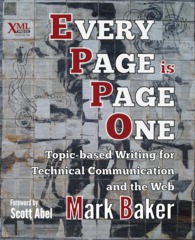 There’s a joke in education along the lines that students are taught the notes their teachers wrote down at university 20 years earlier…without going through the heads of either.
There’s a joke in education along the lines that students are taught the notes their teachers wrote down at university 20 years earlier…without going through the heads of either.
I mention this because there have been a number of technical communicators who have started to question the technical writing best practices that have been taught to student Technical Authors for the past 30+ years. At Cherryleaf, we show on our advanced technical writing techniques course how some of the largest websites have been breaking the generally accepted rules for writing User Assistance – companies that test and test again to see what works best for their users. Ray Gallon of CultureCom has been developing his cognitive approach to User Assistance, and Mark Baker has been developing and promoting the idea of “Every Page is Page One” (EPPO) Help topics.
Mark has published his ideas in a new book called “Every Page is Page One“. I was asked to review an early draft of the book, and, over Christmas, I was sent a copy of the published version.
In a nutshell, Mark’s argument is that, with Web-based content, you don’t know the context in which people are reading a Help page. You cannot assume that they have read any other pages prior to reading this topic. Therefore, you need to treat every page as Page One, the starting point, and include more introductory, contextual information in your topics. He argues that most Technical Authors have misunderstood minimalism, and the EPPO approach is actually more consistent with how John Carroll (the creator of minimalism) recommended User Assistance should be written.
The book provides recommendations on the level of detail you should include on a page before you need to create a new topic, and when and where to create links to other pages. He also compares EPPO to Information Mapping and DITA, and outlines how EPPO can complement these standards.
Reading the early PDF draft with a reviewer’s eye was struggle at times, but reading the final version in printed book format was an easy and enjoyable exercise. Perhaps reading some sections for a second time helped, as well.
We agree with a great deal of Mark’s ideas. We agree with the general idea of self-contained topics that provide the context for a task. We agree with the need for mini-Tables of Contents and a bottom-up approach to writing. We agree that tasks should include some contextual information. We agree online content can be atomised too much. We also liked his analysis of why screencasts are so popular, and the secrets to their success.
We have a few minor issues. Mark cautions against duplicating content on more than one Web page, because it’s bad for Search Engine Optimisation. We believe you should write efficiently in a way that’s best for the user, and that it’s up to the Search Engines to improve their algorithms so they can differentiate between “good” duplication and “bad” duplication. Google should be adapting and learning from the way good content is written, not us having to create sub-optimal content in order to satisfy Google.
It’s a book for people involved today in writing online User Assistance. Although the book is very clear and well structured, you probably need to have some experience of creating User Assistance to fully understand everything that’s covered in the book. It’s an important contribution to the discussion over whether technical communicators have focused too much on production efficiencies to the detriment of creating content that’s actually of value to their users. It’s worth getting a copy of this book.

I wrote about SEO and duplicate content last week. Duplicate content should be more of a red flag for people who single source multiple help files online. It’s not just about Google learning to distinguish between good and bad content. It’s that Google will only serve up the best version of the content. Google is never going to serve up duplicate versions of the same material, because that would result in poor search results. Google wants to present a variety of sources to the user.
If you have several different versions of the same content, and only one surfaces, how do you prioritize the right one to surface? You have to specify which version is the canonical one through a canonical link on the page.
But beyond the SEO aspects, I think it’s weird to have multiple versions of the same content online. That paradigm works in the print world maybe, but not online.